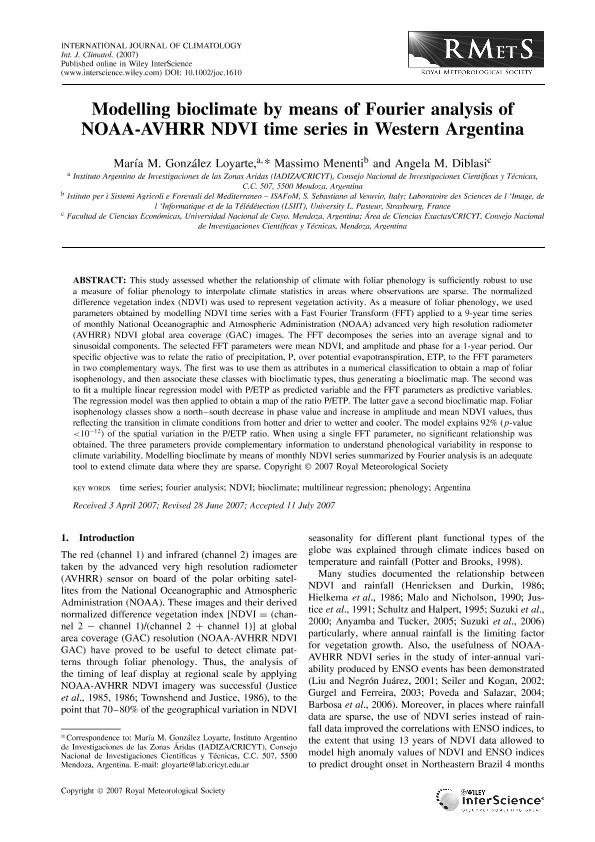Artículo
Modelling bioclimate by means of Fourier analysis of NOAA-AVHRR NDVI time series in Western Argentina
Fecha de publicación:
12/2008
Editorial:
John Wiley & Sons Ltd
Revista:
International Journal of Climatology
ISSN:
0899-8418
Idioma:
Inglés
Tipo de recurso:
Artículo publicado
Clasificación temática:
Resumen
This study assessed whether the relationship of climate with foliar phenology is sufficiently robust to use a measure of foliar phenology to interpolate climate statistics in areas where observations are sparse. The normalized difference vegetation index (NDVI) was used to represent vegetation activity. As a measure of foliar phenology, we used parameters obtained by modelling NDVI time series with a Fast Fourier Transform (FFT) applied to a 9-year time series of monthly National Oceanographic and Atmospheric Administration (NOAA) advanced very high resolution radiometer (AVHRR) NDVI global area coverage (GAC) images. The FFT decomposes the series into an average signal and to sinusoidal components. The selected FFT parameters were mean NDVI, and amplitude and phase for a 1-year period. Our specific objective was to relate the ratio of precipitation, P, over potential evapotranspiration, ETP, to the FFT parameters in two complementary ways. The first was to use them as attributes in a numerical classification to obtain a map of foliar isophenology, and then associate these classes with bioclimatic types, thus generating a bioclimatic map. The second was to fit a multiple linear regression model with P/ETP as predicted variable and the FFT parameters as predictive variables. The regression model was then applied to obtain a map of the ratio P/ETP. The latter gave a second bioclimatic map. Foliar isophenology classes show a north-south decrease in phase value and increase in amplitude and mean NDVI values, thus reflecting the transition in climate conditions from hotter and drier to wetter and cooler. The model explains 92% (p-value <10-12) of the spatial variation in the P/ETP ratio. When using a single FFT parameter, no significant relationship was obtained. The three parameters provide complementary information to understand phenological variability in response to climate variability. Modelling bioclimate by means of monthly NDVI series summarized by Fourier analysis is an adequate tool to extend climate data where they are sparse.
Archivos asociados
Licencia
Identificadores
Colecciones
Articulos(IADIZA)
Articulos de INST. ARG DE INVEST. DE LAS ZONAS ARIDAS
Articulos de INST. ARG DE INVEST. DE LAS ZONAS ARIDAS
Citación
Gonzalez Loyarte, Maria Margarita; Menenti, Massimo; Diblasi, Angela Magdalena; Modelling bioclimate by means of Fourier analysis of NOAA-AVHRR NDVI time series in Western Argentina; John Wiley & Sons Ltd; International Journal of Climatology; 28; 9; 12-2008; 1175-1188
Compartir
Altmétricas




